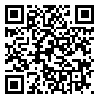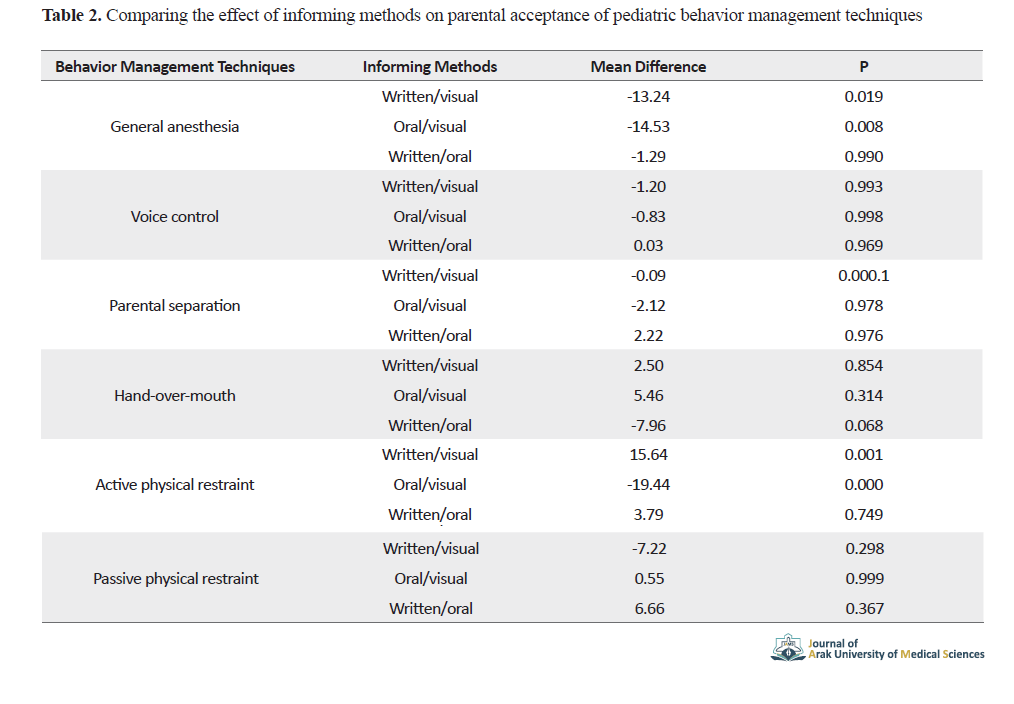BibTeX | RIS | EndNote | Medlars | ProCite | Reference Manager | RefWorks
Send citation to:
URL: http://jams.arakmu.ac.ir/article-1-6176-en.html
2- Department of Pediatric Dentistry, Faculty of Dentistry, Arak University of Medical Sciences, Arak, Iran. ,
Introduction
Most children who see a dentist are anxious, and it is common for children not to cooperate during dental treatment [1]. Pediatric dentistry tries to have a positive effect on children. For which purpose, advanced pharmacological and behavior management techniques are used [2, 3]. However, parents may decide not to accept any of these methods [3]. The more positive the attitude of parents towards these methods, the less stress is transferred from the parents to the child and the cooperation of parents with the dentist in using these methods increases [5]. The purpose of informing is to introduce the pediatric behavior management techniques to parents, which may increase their acceptance and satisfaction with these methods. Various methods of providing information to parents include oral/visual presentation and written report [3]. The aim of this study was to compare the effect of different methods of parental informing on their acceptance of behavior management techniques and determine the reasons for their non-acceptance.
Materials and Methods
This quasi-experimental study was conducted on one 162 parents of 3-7-year-old uncooperative children who were candidates for dental treatment. They were randomly divided into three groups. Their acceptance about 6 behavior management techniques including general anesthesia, voice control, hand-over-mouth, parental separation, active/passive physical restraint were assessed by questionnaire. After determining the level of acceptance, the information was presented via writing report, and oral and visual (film presentation) methods. In written method, the information on each of the behavior management techniques was provided in writing. In visual method, a researcher-made film was produced to demonstrate behavior management techniques. Their acceptance and the reasons for non-acceptance were re-evaluated. Results were analyzed in SPSS V. 23 software using ANOVA and t-test (Table 1 & Table 2).
Results
According to participants, the order of acceptance of pediatric behavior management techniques was: parental separation, voice control, active physical restraint, general anesthesia, passive physical restraint, and hand-over-mouth techniques. The effectiveness of all informing methods on increasing the acceptance of pediatric behavior management techniques by parents was statistically significant. The effect of visual presentation method in general anesthesia technique was lower than that of other methods, while in active physical restraint technique its effect was more than that of other methods. There was no statistical difference in other behavior management techniques, and the effectiveness of all three informing methods was similar. Without categorizing behavior management techniques, the effectiveness of the written informing method was more than the visual informing method and the effect of visual method was more than the oral informing method, but the difference was not statistically significant. The most important reasons for not accepting different pediatric behavior management techniques were as follows:
● General anesthesia technique: Complications and harm to the child;
● Voice control technique: Emotional problems and harm to the child
● Parental separation technique: Lack of positive effect on the child’s cooperation, creating emotional problems, worrying about its harm to the child, and believing in a more appropriate and convenient alternative method;
● Hand-over-mouth and active physical restraint techniques: Emotional problems and harm to the child;
● Passive physical restraint: Emotional problems and harm to the child, consequences and belief in a better way to get cooperation.
Discussion and Conclusion
Parents’ acceptance of pharmacological and aggressive behavioral management techniques is low [3]. However, their attitudes may change over time [10]. Therefore, parental awareness and acceptance of behavioral management techniques seems to be necessary [11]. In this study, the highest parental acceptance was related to the parental separation technique and the lowest acceptance was related to the hand-over-mouth and passive physical restraint techniques, which is in agreement with the results of other studies [1, 12-14]. The hand-over-mouth technique is no longer recommended by the AAPD [15, 16]. The use of papoose boards can lead to physical and psychological damage [5].
The hand-over-mouth and passive physical restraint techniques should be discarded. In this study, in comparison with the studies by Paryab et al. [3] and Razavi and Purtaji [17], the acceptance rate of general anesthesia had increased trend. The main reason for parents not accepting behavioral management techniques was the concern about their emotional problems and harm to the child. By increasing the awareness of parents, their worries can be reduced because the parents who are less concerned about their children’s behavioral management techniques, show higher rate of acceptance [14]. It was concluded that parental informing increases parental acceptance of pediatric behavior management techniques and should be considered by dentists.
Ethical Considerations
Compliance with ethical guidelines
This study obtained its ethical approval from the Research Ethics Committee of Arak University of Medical Sciences (Code: IR.ARAKMU.REC.1398.102).
Funding
The present paper was extracted from the MSc. thesis of the first author, Department of Pediatric Dentistry, Faculty of Dentistry, Arak University of Medical Sciences, Arak.
Authors' contributions
All authors met the writing standards based on the recommendations of the International Committee of Medical Journal Editors (ICMJE).
Conflicts of interest
The authors declared no conflict of interest.
References
1.Jafarzadeh M, Kooshki F, Malekafzali B, Ahmadi S. Attitude of parents referred to the department of pediatric dentistry towards different behavioral management techniques used in pediatric dentistry. J Dent Sch Shahid Beheshti Univ Med Sci. 2015; 33(1):44-50.
2.Boka V, Arapostathis K, Vretos N, Kotsanos N. Parental acceptance of behaviour-management techniques used in paediatric dentistry and its relation to parental dental anxiety and experience. Eur Arch Paediatr Dent. 2014; 15(5):333-9. [DOI:10.1007/s40368-014-0119-y] [PMID]
3.Paryab M, Afshar H, Mohammadi R. Informing parents about the pharmacological and invasive behavior management techniques used in pediatric dentistry. J Dent Res Dent Clin Dent Prospects. 2014;8(2):95-100. [DOI:10.5681/joddd.2014.017] [PMID] [PMCID]
4.Elango I, K Baweja D, K Shivaprakash P. Parental acceptance of pediatric behavior management techniques: A comparative study. J Indian Soc Pedod Prev Dent. 2012; 195-200. [DOI:10.4103/0970-4388.105010] [PMID]
5.McDonald RE, Avery DR. Foreword. In: Dean JA, editor. McDonald and Avery’s Dentistry for the Child and Adolescent (Tenth Edition). St. Louis: Mosby; 2016. [DOI:10.1016/B978-0-323-28745-6.06001-4]
6.Adewumi A HM, king JM. Children and informed consent: A study of children’s perceptions and involvement in consent to dental treatment. Br Dent J 2001; 191:256-9. [DOI:10.1038/sj.bdj.4801157a] [PMID]
7.Abushal MS, Adenubi JO. Attitudes of Saudi parents toward behavior management techniques in pediatric dentistry. J Dent Child (Chic). 2003; 70(2):104-10. [PMID]
8.Wright GZ KA, Wright GZ. Behavior management in dentistry for children. Hoboken; John Wiley & Sons, Inc: 2014. [DOI:10.1002/9781118852446]
9.Eaton JJ, McTigue DJ, Fields HW, Jr., Beck M. Attitudes of contemporary parents toward behavior management techniques used in pediatric dentistry. Pediatr Dent. 2005; 27(2):107-13. [PMID]
10.Tsuchihashi N UN, Takagi Y, Miwa Z, Sugimo K. Internal stress in children and parental attitude to dental treatment with passive restraint. Pediatr Dent J 2012; 22:170-7. [DOI:10.1016/S0917-2394(12)70268-9]
11.Eshghi A, Rezaeifar M, jafarzadeh Samani M, Malekafzali B, Eftekhari M. Evaluation of parental view toward dental treatment under general anesthesia in Isfahan. J Adv Med Biomed Res. 2010;18(73):67-75. http://zums.ac.ir/journal/article-1-1304-fa.html
12.Al Daghamin S BM AS, AlObaidi F, Kakti A. Behavior management techniques in pediatric dentistry: how well are they accepted? Acad J Ped Neonatol. 2017; 5:1-6.
13.Acharya S, Acharya Sonu S, Leite Cavalcanti A, Wilney W, Padilha N. parental acceptance of various behaviour management techniques used in pediatric dentistry: a pilot study in odisha, india. Pesquisa Brasileira em Odontopediatria e Clínica Integrada. 2017; 2017(1):e3728. [DOI:10.4034/PBOCI.2017.171.26]
14.Allen KD, Hodges ED, Knudsen SK. Comparing four methods to inform parents about child behavior management: how to inform for consent. Pediatr Dent. 1995; 17(3):180-6. [PMID]
15.Roberts JF, Curzon ME, Koch G, Martens LC. Review: Behaviour management techniques in paediatric dentistry. Eur Arch Paediatr Dent. 2010; 11(4):166-74. [DOI:10.1007/BF03262738] [PMID]
16.American Academy of Pediatric Dentistry (AAPD). behavior guidance for the pediatric dental patient. Am Acad Pediatr Dent. https://www.aapd.org/globalassets/media/policies_guidelines/bp_behavguide.pdf
17.Razavi S, Purtaji B. Determining the behavior management technique’s acceptance of mothers referred to the department of pediatric dentistry in Qazvin (2007). J Qazvin Univ Med Sci. 2009; 13(3):81-6. http://journal.qums.ac.ir/article-1-879-en.html
18.American Academy of Pediatric Dentistry. Guideline on behavior guidance for the pediatric dental patient. 2009; 30(7):125-33.
19.Luis de León J1 GJF, Bellet Dalmau LJ. Acceptance by Spanish parents of behaviour management techniques used in paediatric dentistry. Eur Arch Paediatr Dent. 2010; 11(4):175-8. [DOI:10.1007/BF03262739] [PMID]
20.Saleh M MS, Sabiha A. Parental attitude toward behavioral management techniques in dental practice with school children in Kuwait. Med Princ Pract. 2011; 20:350-55. [DOI:10.1159/000323758] [PMID]
| Rights and permissions | |
 |
This work is licensed under a Creative Commons Attribution-NonCommercial 4.0 International License. |











